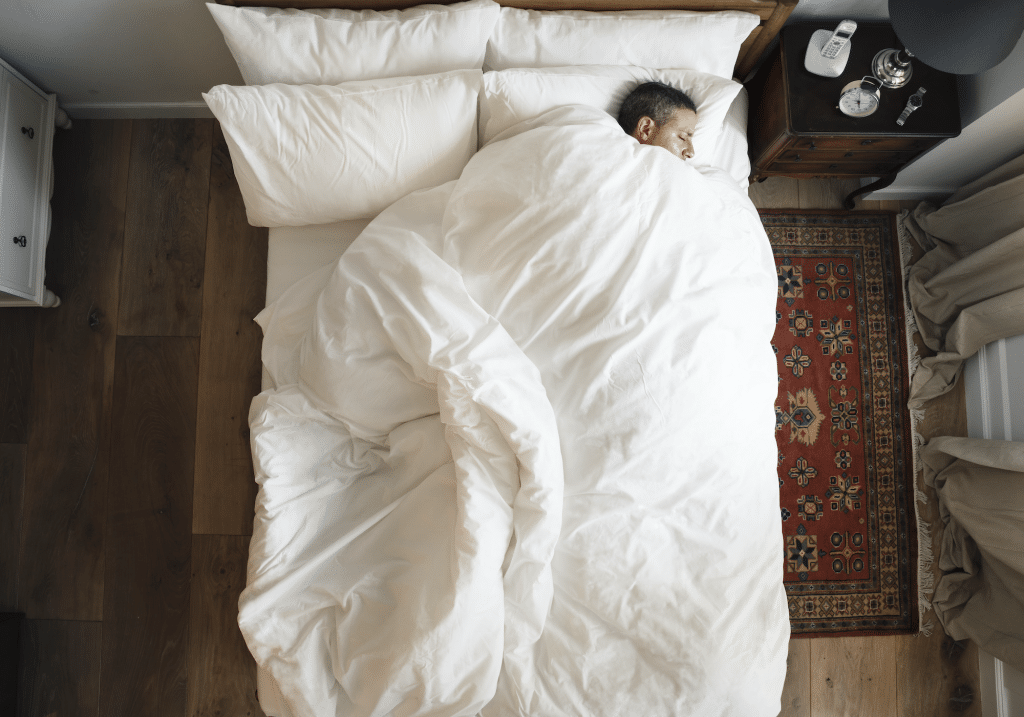
Snoring and sleep apnoea are both considered sleep-disordered breathing conditions. Snoring sits on the less serious end of the spectrum, while obstructive sleep apnoea (OSA) is more severe. Understanding the difference and the potential long-term health impacts is key to improving your sleep and overall well-being.
Snoring is the sound of turbulent air moving through the upper airway. Large gusts of air make tissues in the throat, like the uvula, base of the tongue, epiglottis, and tonsils vibrate.
Snoring affects people of all ages, but as muscle tissue becomes floppier with age, it’s more common in people over 40.
By its nature, snoring involves big or ‘over’-breathing, which is considered dysfunctional breathing, and is a focus of the Buteyko Breathing Technique (BBT). BBT retrains dysfunctional breathing patterns, including over-breathing, to restore healthier airflow.
Many people temporarily suppress snoring by taping the mouth closed at night. While this can reduce the noise, it doesn’t address the root cause of dysfunctional breathing and the over-breathing remains.
If you regularly snore, it’s very likely your daytime breathing is also dysfunctional. Signs of dysfunctional breathing can include:
Retraining your breathing with BBT can help reduce snoring and support improvement in other conditions, including mild OSA.
OSA is a more severe form of sleep-disordered breathing. It’s characterised by repetitive pauses in breathing during sleep, caused by partial or complete blockage of the upper airway. These pauses can last seconds to minutes and often happen many times per night, reducing blood oxygen levels and disrupting sleep.
OSA is diagnosed via a sleep study, which can be conducted in a clinic or at home. While the sleep study is the gold standard, screening questionnaires can give an early indication of your risk.
In a study published by the Lancet medical journal, it is estimated that around 1 billion people worldwide have OSA untreated OSA carries significant health risks, including:
Treatment options include CPAP machines, dental splints, or surgery. Regardless of which treatment you choose, breathing retraining with BBT can improve your condition by addressing the underlying dysfunctional breathing.
Not everyone who snores has OSA, but nearly everyone with OSA snores. Historically, OSA was known as Pickwickian syndrome, named after a corpulent Dickensian character. Thereafter, being overweight was considered a leading cause of OSA.
Research now recognises multiple phenotypes, or ‘varieties’ of OSA, and you don’t need to be overweight to be affected. In most cases, dysfunctional breathing contributes to the problem, which is why BBT can be helpful as an adjunctive therapy. The various phenotypes include; Pcrit, Loop Gain, described below.
Pcrit measures how easily the upper airway collapses during sleep. A high Pcrit means the airway is more likely to collapse, leading to hypopneas (reduced airflow) or apnoeas (pauses in breathing).
Factors influencing Pcrit include: fat accumulation, anatomical variations, and increased airflow. BBT focuses on slower, quieter breathing, which helps reduce Pcrit and stabilise the airway.
Loop gain refers to how sensitive the respiratory control system is to changes in carbon dioxide (CO₂) levels. People with high loop gain overreact to small CO₂ increases, which can lead to frequent awakenings and snoring.
BBT can help improve CO₂ tolerance, reducing these exaggerated responses and improving overall breathing stability.
The upper airway relies on over 20 muscles involved in breathing, chewing, speech, and swallowing. During sleep, these muscles can relax too much, increasing the risk of airway closure.
BBT incorporates techniques to recruit and strengthen these muscles, including:
Nasal breathing also releases nitric oxide, which supports airway muscle function. By improving muscle tone and breathing mechanics, BBT can reduce both snoring and mild OSA symptoms.
Not all snoring is dangerous. For people with simple snoring, natural strategies can be very effective:
For practical guidance, see 5 Tips to Stop Snoring Naturally.
If you’re unsure whether your snoring is harmless or linked to OSA, understanding the mechanics can help. Check out What Causes Snoring for a detailed explainer.
Snoring and sleep apnoea exist on a spectrum, from mild to severe. Understanding causes, risk factors, and treatment options is the first step toward better sleep and long-term health.
Breathing retraining with BBT is a safe, natural approach that addresses one of the root causes of snoring and mild OSA. By improving airway stability, CO₂ tolerance, and muscle recruitment, it can reduce symptoms, enhance sleep quality, and support overall wellbeing.
There’s no one-size-fits-all solution, but you have options:
Better sleep starts with breathing the right way, take the first step today!
Inefficient breathing (chronic over-breathing) is often the missing foundational habit that drives systemic stress, poor sleep, and anxiety.
Learn how to quickly normalise your breathing volume to calm your nervous system and improve your overall systemic health.